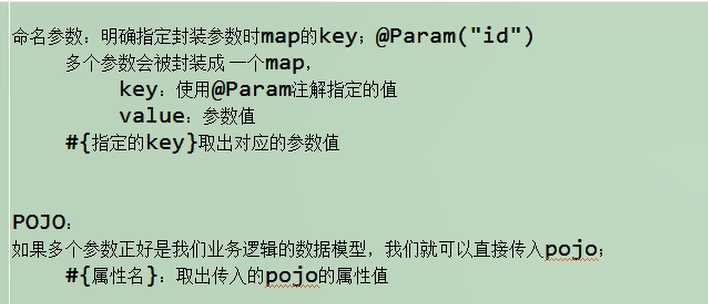Mybatis——映射文件,缓存,整合
Posted lemonades
tags:
篇首语:本文由小常识网(cha138.com)小编为大家整理,主要介绍了Mybatis——映射文件,缓存,整合相关的知识,希望对你有一定的参考价值。
映射文件学习过程: 1.增删改查;2.获取自增主键;3.参数处理:单个,多个参数;4.查询返回值处理;5.动态SQl;6.缓存;7.整合Spring
1.增删改查:
<!--id 对应里边的方法-->
<select id="getStudentById" resultType="mybatis.model.Student">
select * from student where id = #id
</select>
<!--void addStudent(Student student);-->
<insert id="addStudent" parameterType="mybatis.model.Student" useGeneratedKeys="true" keyProperty="id">
insert into student (name,address,phone) values (#name,#address,#phone)
</insert>
<!--void updateStudent(Student student);-->
<update id="updateStudent" >
update student set name=#name,address=#address,phone=#phone where id=#id
</update>
<!--void deleteStudent(int id);-->
<delete id="deleteStudent">
delete from student where id=#id
</delete>
2.获取自增主键的值:useGeneratedKeys="true" keyProperty="id"
<!--void addStudent(Student student);-->
<insert id="addStudent" parameterType="mybatis.model.Student" useGeneratedKeys="true" keyProperty="id">
insert into student (name,address,phone) values (#name,#address,#phone)
</insert>
3.传入SQL语句的参数处理:


4.查询返回值处理:
1)ResultMap的使用:自定义resultMap
<!--resultMap的使用-->
<resultMap id="studentMap" type="mybatis.model.Student">
<!--主键-->
<id column="id" property="id"></id>
<!--其他列-->
<result column="name" property="name"/>
<result column="address" property="address"/>
<result column="phone" property="phone"/>
</resultMap>
<!--Student getStudentById_resultMap(int id);-->
<select id="getStudentById_resultMap" resultMap="studentMap">
select * from student where id=#id
</select>
//测试使用ResultMap
Student student2 = studentMapper.getStudentById_resultMap(2);
session.commit();
//打印对象
System.out.println(student2);
2)ResultMap的使用:(里边各种各样的标签属性 ) A.关联查询:对级联属性的封装;B. 使用association指定哪个属性是关联对象; C.使用association分步查询(并设置属性可 进行延迟加载 / 懒加载);
D. 使用collection指定哪个属性是关联对象(这个属性有多个,所以是一个集合);E.使用collection分步查询(并设置属性可 进行延迟加载 / 懒加载);
F.在ResultMap里边,使用鉴别器:discriminator
5.动态SQl:动态地拼接SQL语句
<if test=" id != null "> id=# id </if> : 一般从传进来的参数进行判断。 test里边使用OGNL语法规则
<where> </where> 用来代替SQL语句里的where 条件,将所有的查询条件包括在内,如果条件多出来 and 和 or 会自动被删掉(和 <if> and name=#name</if> 嵌套使用)。
<trim></trim> 自定义字符串截取规则,比<where>标签的截取更加灵活,可以给整个字符串加上(或去掉)前后缀
<choose></choose> 分支选择,相当于switch语句 里面有 <when>和<otherwise>,相当于 switch的 case 和default 语句
<set></set>相当于update ----->update table_name set id=1, name=‘yang‘ 语句中的set,会自动去掉<if>标签后多出来的 , 逗号。 与<where>标签类似,可用<trim>标签代替
<foreace>批量保存信息
动态sql有两个内置参数:_parameter _databaseId: 可以用于<if></if>标签里面进行判断
<bind>标签可以将参数绑定,再拼接符号,如%Name% ,再从SQL语句中使用
* SQL片段:抽取可重用的SQL片段
6.缓存:
https://www.cnblogs.com/whgk/p/6722497.html
使一级缓存失效的四种情况:
1)使用不同sqlsession
2)清空sqlsession.clearCache(); ------>清理的是一级缓存
3)查询条件不同
4)查询条件相同,两次查询之间有进行 增删改查 ,相对应的缓存会被清理。
5)给查询的mapper标签设置flushCache="true"(select默认为false, insert、delete、update默认true),每次调用映射文件里的方法,都会清理掉缓存。
注:二级缓存时,sqlsession关闭后,缓存才会从一级缓存提交到二级缓存。
6)localCacheScrop 本地缓存作用域 也可以设置一级缓存不起作用
EHcahe:
入门:https://www.cnblogs.com/jingmoxukong/p/5975994.html
以上是关于Mybatis——映射文件,缓存,整合的主要内容,如果未能解决你的问题,请参考以下文章
MyBatis Spring整合配置映射接口类与映射xml文件
springboot整合mybatis使用xml映射文件和使用注解两种方式的切换